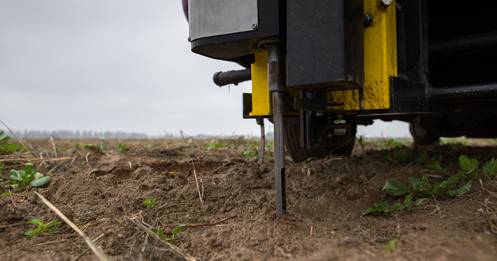Down To Earth
Nov 13, 2020
Megan Hasenour | Marketing Communications Manager

We have all heard the expression “grounded” and “down to earth”. In these instances, these phrases convey soil with a sense of place in our world and geography – giving us a vibe that soil mean “home”.
Let’s talk more about “Soil”.
Soil is a material composed of five ingredients:
Soil organic matter includes plants, animals and microbial residues in various states of decomposition. Organic Matter is in fact one of the key factors that identifies the quality of the soil. The soil microbes include bacteria, fungi and archaea.
Did you know that a teaspoon of rich soil can contain ONE BILLION bacteria?
As we know, soil is the primary source of nutrients and water for plant life. You could consider soil the “service provider” for plants. Soil cycles and recycles nutrients and wastes converting them into biologically available forms and collecting them for postponed consumption.
Like it or not, the organic make-up of soil has a big impact on the productivity of your crops.
For you to get a better understanding of your soil and how you can ensure it has the available nutrients for your crops – obtain a soil analysis!
A soil analysis can be conducted by obtaining soil samples of your acres. Superior Ag’s Precision Ag team are experts in this area! They can provide a customized report with recommendations that would increase the productivity of your soil. It’s important to increase nutrient efficiency with enhanced reporting practices in our soil testing.
Healthy soil is the foundation of productive and sustainable agriculture.
Contact your Local Agronomy Branch to schedule a soil analysis on your soil today!
References
Ahrens, R. J. & Arnold, R. W. "Soil taxonomy," in Handbook of Soil Science, ed. M. Summer (CRC Press, 2000) E117-E135.
Brady, N. C. & Weil, R. R. The Nature and Properties of Soils, 14th ed. Upper Saddle River, NJ: Prentice Hall, 2008.
Food and Agriculture Organization of the United Nations (FAO). Guidelines for Soil Description, 4th ed. FAO, Rome, 2006. ftp://ftp.fao.org/docrep/fao/009/a0541e/a0541e00.pdf
Haygarth P. M. & Ritz, K. The future of soils and land use in the UK: Soil systems for the provision of land-based ecosystem services. Land Use Policy 26S:S187-S197, 2009.
Jenny, H. The Factors of Soil Formation: A System of Quantitative Pedology. New York, NY: Dover Press, 1941.
Soil Survey Division Staff. Soil Survey Manual. Soil Conservation Service, United States Department of Agriculture, Handbook 18, 1993. http://soils.usda.gov/technical/manual/

We have all heard the expression “grounded” and “down to earth”. In these instances, these phrases convey soil with a sense of place in our world and geography – giving us a vibe that soil mean “home”.
Let’s talk more about “Soil”.
Soil is a material composed of five ingredients:
- Minerals
- organic matter
- living organisms
- gas
- water
Soil organic matter includes plants, animals and microbial residues in various states of decomposition. Organic Matter is in fact one of the key factors that identifies the quality of the soil. The soil microbes include bacteria, fungi and archaea.
Did you know that a teaspoon of rich soil can contain ONE BILLION bacteria?
As we know, soil is the primary source of nutrients and water for plant life. You could consider soil the “service provider” for plants. Soil cycles and recycles nutrients and wastes converting them into biologically available forms and collecting them for postponed consumption.
Like it or not, the organic make-up of soil has a big impact on the productivity of your crops.
For you to get a better understanding of your soil and how you can ensure it has the available nutrients for your crops – obtain a soil analysis!
A soil analysis can be conducted by obtaining soil samples of your acres. Superior Ag’s Precision Ag team are experts in this area! They can provide a customized report with recommendations that would increase the productivity of your soil. It’s important to increase nutrient efficiency with enhanced reporting practices in our soil testing.
Healthy soil is the foundation of productive and sustainable agriculture.
Contact your Local Agronomy Branch to schedule a soil analysis on your soil today!
References
Ahrens, R. J. & Arnold, R. W. "Soil taxonomy," in Handbook of Soil Science, ed. M. Summer (CRC Press, 2000) E117-E135.
Brady, N. C. & Weil, R. R. The Nature and Properties of Soils, 14th ed. Upper Saddle River, NJ: Prentice Hall, 2008.
Food and Agriculture Organization of the United Nations (FAO). Guidelines for Soil Description, 4th ed. FAO, Rome, 2006. ftp://ftp.fao.org/docrep/fao/009/a0541e/a0541e00.pdf
Haygarth P. M. & Ritz, K. The future of soils and land use in the UK: Soil systems for the provision of land-based ecosystem services. Land Use Policy 26S:S187-S197, 2009.
Jenny, H. The Factors of Soil Formation: A System of Quantitative Pedology. New York, NY: Dover Press, 1941.
Soil Survey Division Staff. Soil Survey Manual. Soil Conservation Service, United States Department of Agriculture, Handbook 18, 1993. http://soils.usda.gov/technical/manual/